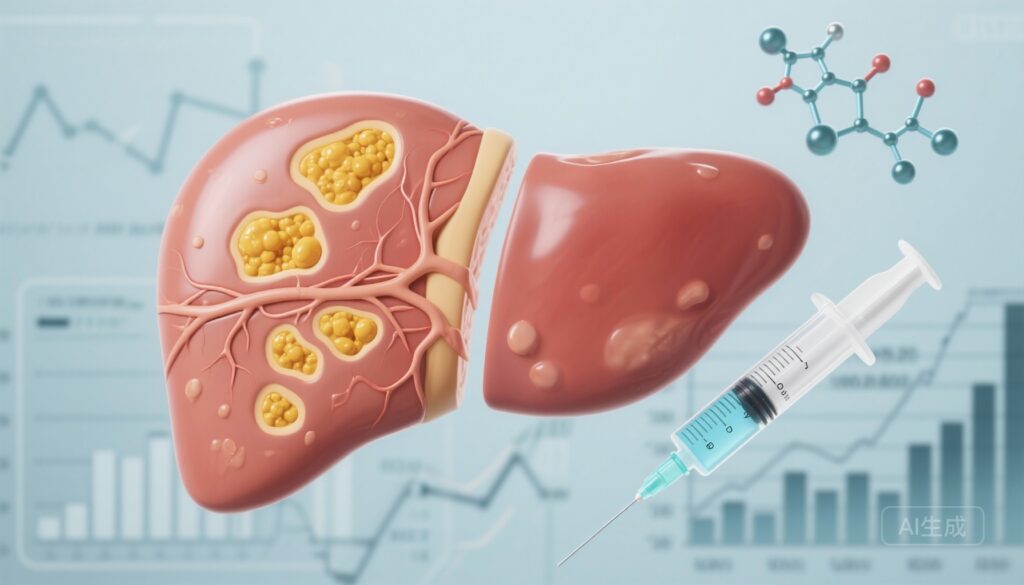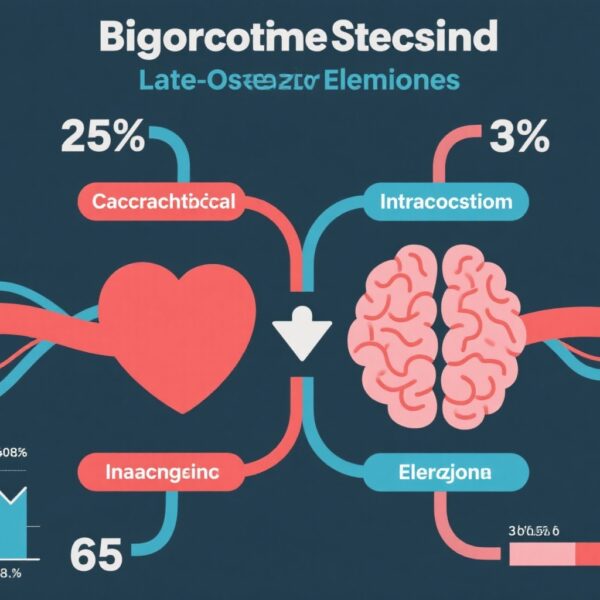Highlights
– Pemvidutide, a once‑weekly dual GLP‑1 and glucagon receptor agonist, produced large reductions in liver fat (up to ~75% relative reduction) over 24 weeks in MASLD patients and caused small but statistically significant reductions in AI‑quantified fibrosis in adults with MASH and F2–F3 disease.
– The IMPACT phase 2 study reported absolute reductions in AI‑measured fibrosis area of −0.40% (1.2 mg) and −0.69% (1.8 mg) vs placebo at 24 weeks; a further MASLD extension showed dose‑dependent liver fat normalization in a majority at the 1.8 mg dose.
– Safety appeared acceptable in these early trials, with weight loss and low rates of adverse events reported; however, clinical significance of short‑term continuous fibrosis reductions and long‑term outcomes remain unproven.
Background and clinical need
Metabolic dysfunction‑associated steatotic liver disease (MASLD) and its progressive form, metabolic dysfunction‑associated steatohepatitis (MASH; commonly still called NASH), are highly prevalent conditions linked to overweight, obesity, insulin resistance and type 2 diabetes. Excess hepatic fat is a key driver of inflammation and fibrogenesis that can progress to cirrhosis, hepatocellular carcinoma and liver‑related mortality.
At present, there are no widely approved pharmacotherapies specifically for MASH that reliably improve both steatohepatitis and fibrosis with proven effects on hard clinical outcomes. Lifestyle intervention and weight loss remain central but achieving and maintaining clinically meaningful weight loss is challenging. The pathophysiology of MASLD/MASH suggests two complementary therapeutic targets: systemic metabolic control and direct hepatic metabolic modulation. Dual agonists that combine GLP‑1 receptor (GLP‑1R) effects (weight loss, improved insulin sensitivity) with glucagon receptor (GCGR) activity (increased hepatic fatty acid oxidation, reduced lipogenesis) could therefore offer stronger hepatic benefits than GLP‑1R agonism alone.
Study designs and endpoints
IMPACT study (phase 2, AI‑quantified fibrosis)
The IMPACT trial enrolled 212 adults with biopsy‑confirmed MASH and stage F2 or F3 fibrosis who were randomized to once‑weekly subcutaneous pemvidutide 1.2 mg (n = 41), 1.8 mg (n = 85) or placebo (n = 86). Liver biopsies were centrally reviewed by conventional pathology and were further quantified by an investigational research algorithm, Liver Explore, which provides continuous measures of pathologic fibrosis area (it is not a diagnostic tool). The primary outcome reported was change from baseline to 24 weeks in the proportion of the biopsy sample showing pathologic fibrosis. Patients missing biopsy data or who discontinued treatment early were conservatively counted as nonresponders for categorical analyses.
MASLD extension trial (randomized extension, 24 weeks)
A separate randomized controlled extension of a double‑blind pemvidutide trial included 64 completers who had been randomized originally 1:1:1:1 to pemvidutide 1.2 mg, 1.8 mg, 2.4 mg or placebo for 12 weeks and were offered an additional 12 weeks on their assigned dose for a total of 24 weeks. Participants were stratified by presence of type 2 diabetes. The primary efficacy endpoint was relative reduction in liver fat measured by MRI‑proton density fat fraction (MRI‑PDFF) at 24 weeks.
Key findings
AI‑quantified fibrosis (IMPACT)
Using the Liver Explore research algorithm, investigators reported statistically significant reductions in the continuous area of pathologic fibrosis with both pemvidutide doses versus placebo at 24 weeks. Absolute changes were −0.40% (P = .039) for 1.2 mg and −0.69% (P < .001) for 1.8 mg versus an increase of +0.38% with placebo.
Further compartmental analyses suggested activity in both the ‘‘early’’ and ‘‘advanced’’ fibrosis compartments. In categorical analyses using prespecified relative reductions, 24% (1.2 mg) and 34% (1.8 mg) of participants achieved a ≥60% relative decrease in early fibrosis compared with placebo, and 27% of patients in the 1.8 mg group had a ≥60% relative reduction in advanced fibrosis versus 11% with placebo.
Interpretation: The signal for reduction in continuous fibrosis area is notable, particularly because most anti‑fibrotic trials rely on categorical (stage) improvement such as ≥1 stage improvement in fibrosis. However, absolute reductions in percent area reported here are numerically small and must be interpreted in the context of baseline pathology, measurement variability, clinical relevance of small continuous changes and the novel nature of the AI tool.
Imaging, liver fat and weight (MASLD 24‑week extension)
After 24 weeks, pemvidutide produced large, dose‑dependent reductions in liver fat by MRI‑PDFF: 56.3% (1.2 mg), 75.2% (1.8 mg) and 76.4% (2.4 mg) relative reductions vs 14.0% with placebo (P < .001 for all doses vs placebo). At the 1.8 mg dose, 84.6% of participants achieved ≥50% liver‑fat reduction and 53.8% achieved normalization to ≤5% liver fat. Body weight decreased by 6.2% with treatment at 24 weeks (P < .001 vs placebo).
Interpretation: These MRI‑PDFF reductions are large and clinically meaningful: >50% relative reduction in liver fat is associated in prior studies with improvements in histologic steatohepatitis and metabolic measures. Weight loss likely contributes to liver fat reduction, but the magnitude observed—particularly at the 1.8 and 2.4 mg doses—suggests additional hepatic metabolic effects beyond body‑weight change, consistent with the GCGR agonism hypothesis.
Safety
Across the reported cohorts, pemvidutide was generally well tolerated over 12–24 weeks with low incidences of adverse events reported in the extension. The summaries provided note acceptable tolerability at all doses. As with other incretin‑based agents and glucagon agonists, expected class‑related adverse effects include gastrointestinal symptoms (nausea, diarrhea), increases in heart rate, and theoretical metabolic effects related to glucagon activity; however, GLP‑1 co‑agonism tends to mitigate hyperglycemic effects of glucagon receptor activation.
Expert commentary and critical appraisal
Strengths: The two complementary reports provide mechanistic and translationally relevant data—large, objective MRI‑PDFF reductions and AI‑quantified continuous reductions in histologic fibrosis area over 24 weeks. Including biopsy‑based continuous quantification is innovative and may capture early changes that categorical staging misses. The conservative handling of missing biopsy data (counting as nonresponders) reduces risk of optimistic bias in categorical responder analyses.
Limitations and uncertainties:
- Short duration: 24 weeks is short for assessing fibrosis regression that translates into clinically meaningful outcomes (reduced decompensation, HCC or liver‑related mortality). Durable effects over 1–2 years and beyond will be required.
- Clinical relevance of small absolute percent‑area changes: While statistically significant, absolute reductions in fibrosis area were small (fractions of a percent). Whether these correspond to reproducible, clinically meaningful histologic stage improvements or long‑term risk reduction is unknown.
- Novel AI tool: Liver Explore provides continuous measures but is a research algorithm not validated for clinical decision‑making. Reproducibility, inter‑algorithm concordance and correlation with established histologic endpoints require independent validation.
- Sample size and generalizability: The extension cohort (n=64) and the IMPACT subgroups are relatively small; patients with diverse demographics, comorbidities and advanced disease (F4) were not studied here.
- Hard outcomes lacking: Neither trial assesses longer‑term clinical endpoints; regulatory pathways for MASH therapies currently emphasize histologic endpoints (NASH resolution without worsening fibrosis or≥1 stage fibrosis improvement), but linkage to clinical outcomes will be essential.
Biological plausibility and mechanism
Pemvidutide’s dual GLP‑1R/GCGR profile offers a plausible mechanism for both weight‑dependent and weight‑independent hepatic effects. GLP‑1R agonism reduces appetite and body weight and improves insulin sensitivity, while GCGR agonism stimulates hepatic fatty acid oxidation and suppresses lipogenesis—mechanisms that can reduce intrahepatic triglyceride content more potently than weight loss alone. The combination, therefore, may accelerate reductions in liver fat and downstream inflammatory and fibrotic signaling.
Implications for clinical practice and next steps in research
For clinicians, these data are promising but preliminary. Pemvidutide may become an important therapeutic option if phase 3 trials confirm histologic benefit (per accepted endpoints), demonstrate durability, show acceptable long‑term safety, and provide evidence of reduced clinical events. Pending those data, lifestyle modification and current best‑practice management of metabolic risk factors remain the foundation of care.
Recommended next steps for research include:
- Large, adequately powered phase 3 trials with histologic primary endpoints aligned to regulatory guidance (NASH resolution without worsening fibrosis and/or ≥1 stage fibrosis improvement without worsening NASH).
- Longer‑term follow‑up to establish durability of effect and to capture clinical outcomes (decompensation, transplantation, HCC, liver‑related mortality).
- Independent validation of AI‑quantified continuous fibrosis measurements and assessment of their correlation with conventional histologic staging and clinical outcomes.
- Detailed safety surveillance, including cardiovascular monitoring and metabolic effects attributable to glucagon receptor agonism.
- Exploration of combination regimens and sequencing with other metabolic agents (e.g., GLP‑1/GIP agonists) to optimize hepatic and cardiometabolic outcomes.
Conclusion
Pemvidutide demonstrates potent, dose‑dependent reductions in liver fat by MRI‑PDFF and small but statistically significant reductions in AI‑quantified fibrosis area at 24 weeks in early clinical studies. These findings are biologically plausible given the drug’s GLP‑1/GCGR co‑agonism and are clinically encouraging. However, the absolute magnitude of histologic change, the short duration of follow‑up, the use of an investigational AI quantification tool, and limited safety data mean that larger, longer randomized trials with prespecified histologic and clinical endpoints are required before pemvidutide can be recommended as a disease‑modifying therapy for MASH/MASLD.
Funding and clinical trial registration
The 24‑week MASLD trial is registered at ClinicalTrials.gov (NCT05292911). The JHEP Rep report cited below contains the peer‑reviewed account of the 24‑week extension (Browne et al., JHEP Rep. 2025). Details of trial sponsorship and funding were not specified in the summaries provided here; investigators typically disclose sponsorship in the published manuscripts and ClinicalTrials.gov entries.
References
1. Browne SK, Suschak JJ, Tomah S, Gutierrez JA, Yang J, Georges B, Roberts MS, Harris MS. Safety and efficacy of 24 weeks of pemvidutide in metabolic dysfunction‑associated steatotic liver disease: A randomized, controlled clinical trial. JHEP Rep. 2025 Jun 18;7(11):101483. doi: 10.1016/j.jhepr.2025.101483. PMID: 41113119; PMCID: PMC12529369.
2. Presentation at The Liver Meeting 2025 (AASLD): Gutierrez J. Safety and efficacy of 24 weeks of pemvidutide in MASLD. Abstract and presentation materials as publicly available via AASLD 2025 program.
3. Newsome PN, Buchholtz K, Cusi K, Linder M, Okanoue T, Ratziu V, Romero‑Gomez M, et al. A placebo‑controlled trial of subcutaneous semaglutide in nonalcoholic steatohepatitis. N Engl J Med. 2021;384(12):1113–1124. doi:10.1056/NEJMoa2028395.
4. Younossi ZM, Koenig AB, Abdelatif D, Fazel Y, Henry L, Wymer M. Global epidemiology of nonalcoholic fatty liver disease—Meta‑analytic assessment of prevalence, incidence, and outcomes. Hepatology. 2016;64(1):73–84. doi:10.1002/hep.28431.
AI thumbnail prompt (for image generation)
Photorealistic, clinical illustration of a human liver split into two halves: left half with yellowish fat infiltration and fibrotic strands, right half cleaner with reduced fat and smoother surface. Overlay of a transparent syringe and a stylized peptide molecule, faint MRI‑PDFF charts and histology micrograph thumbnails in the background; cool clinical color palette (blues, greens, muted reds), high contrast, horizontal banner layout.



